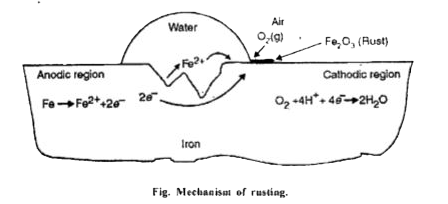Discuss the electrochemical theory of corrosion.Solution in Punjabi
Let us understand the mechanism of corrosion by studying the most familiar example of rusting of iron. Chemically rust is hydrated iron (III) oxide, with a general formula Fe2O3, xH2O Rust is a nonsticking brown-coloured material which gets formed on the iron surface exposed to air and moisture. despite much study, corrosion is a mysterious process and its chemistry not well understood. the most widely accepted theory i.e., electrochemical theory is being discussed here.
Electrochemical theory of rusting. According to this theory, the presence of impurities (with higher reduction potential) on the surface of iron helps in setting up tiny electrochemical cells in the presence of water containing dissolved O2andCO2. such a cell is also called corrosion cell or corrosion couple. in these miniature corrosion cells, pure iron acts as anode and impurities on the surface act as cahotde. moisture having dissolved O2andCO2 in it constitute the electrolytic solution. the formation of rust on the basis of this theory may be explained in the following steps.
(i) Water vapour on the surface of the metal dissolve O2andCO2 from air.
H2O+CO2⇔H2CO3Carbonic acid
Carbonic acid so produced and water dissociate to a small extent as follows.
H2CO3⇔H++HCO3
H2O⇔H++OH−
(ii) Iron in contact with water containing dissolved CO2 undergoes oxidation as follows.
Fe→Fe2++2e−,E∘=−0.44V
The site where the above reaction takes place acts as anode. as a result of the above reaction, iron is converted into ferrous (Fe2+) ions.

(iii) The electrons lost by iron are taken up by the H+ present on the surface of the metal which were produced by the sissociation of H2CO3andH2O. thus H+ ions are converted into hydrogen atom.
2H++2e−→2H
These hydrogen atoms react with dissolved oxygen or oxygen from air to form water.
2H+1/2O2→H2O
The net reduction process at the cathodic area is,
2H++1/2O2+2e−→H2O,E∘=1.23V
(iv) The net reaction of the corrosion cell can be put as:
Fe+2H++1/2O2→Fe2++H2O,E∘cell=1.23V−(−0.44V)=1.67V
(v) The ferrous ions so formed move through water ans come to the surface where these are further oxidized to ferric state by atmospheric oxygen and constitute rust which is hydrated iron (III) oxide.
2Fe2++1/2O2+2H2O→Fe2O3+4H+
Fe2O3+xH2O→Fe2O3.xH2O (Rust)
Since H+ ions are used up in step (iii) and replenished in step (v), it is a true catalyst for the reaction and explains the observation that acids speed up the rate of rust formation.
It is important to note that if water is saline, the electrical conductivity of the electrolyte will increase. this will enchance the process of corrosion. as a result, corrosion becomes a serious problem for metallic articles dipped in salt water.
Topper's Solved these Questions
- ELECTROCHEMISTRYBOOK - BETTER CHOICE PUBLICATIONCHAPTER - ELECTROCHEMISTRYEXERCISE - Numerical Problems
69 Videos
- ELECTROCHEMISTRYBOOK - BETTER CHOICE PUBLICATIONCHAPTER - ELECTROCHEMISTRYEXERCISE - ELECTROLYTIC CELLS AND ELECTROLYSIS
10 Videos
- CO-ORDINATION COMPOUNDSBOOK - BETTER CHOICE PUBLICATIONCHAPTER - CO-ORDINATION COMPOUNDSEXERCISE - QUESTION FROM PREVIOUS BOARD EXAMINATION
59 Videos
- GENERAL PRINCIPLES AND PROCESS OF ISOLATION OF ELEMENTS BOOK - BETTER CHOICE PUBLICATIONCHAPTER - GENERAL PRINCIPLES AND PROCESS OF ISOLATION OF ELEMENTS EXERCISE - Question Bank (6.6 OXIDATION-REDUCTION)
15 Videos
Similar Questions
Derive Nernst equation for the following cell:
NiNi2+(0⋅2M)∣∣∣Cu2+(0⋅2M)∣∣Cu.
View SolutionWhich allotrope of carbon is used in making electrodes ?
View SolutionWrite the IUPAC name of corordination compound [Co(NH3)3ONO]Cl2.
View SolutionName the process from which chlorine is obtained as a bye-product. What will happen if an aqueous solution of NaCl'is:subjected to electrolysis?
View SolutionIn electrochemical corrosion of metals, the metal undergoing corrosion:
View SolutionOn the basis of electrochemical theory of aqueous corrosion, the reaction occurring at the cathode is
View SolutionIn electrochemical corrosion of metals, the metal undergoing corrosion
View SolutionWhat is corrosion ? Discuss the theory of corrosion.
View SolutionOn the basis of electrochemical theory of aqueous corrosion, the reaction occurring at the cathode is
View Solutionविधुत रासायनिक सिद्धांत के अनुसार, आयरन के जलीय संक्षारण में कैथोड पर निम्न क्रिया होगी
View SolutionIn electrochemical corrosion of metals, the metal undergoing corrosion
View Solutionविद्युत रासायनिक सिद्धान्त के अनुसार, आयरन के जलीय संक्षारण में कैथोड पर निम्न क्रिया होगी
View SolutionDiscuss the electrochemical theory of rusting.
View SolutionOn the basis of the electrochemical theory of aqueous corrosion, the reaction occuring at the cathode is …………. .
View SolutionIn electrochemical corrosion of metals, the metal undergoing corrosion:
View SolutionDiscuss the electrochemical theory of corrosion.
View Solution
